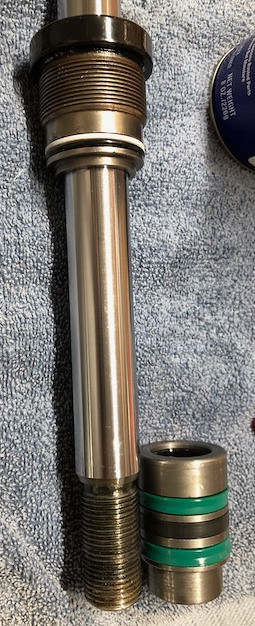Update: Set this project aside for a while, but got back to it yesterday.
Re-cap/Cliff's notes:
The issue with this cylinder was that fluid was leaking past the piston to the dry side. It stopped shortly into the lift because fluid was getting past the seals and not moving the piston. My plan was only to replace the piston seals and not bother with the cap seals since they were not leaking.
The piston seal is apparently not a common part. I only found one online seller who had a part number for the correct size, but the p/n was obsolete and he had to chase 4 or 5 cross reference part numbers before he found one that was available. When I got the parts they were the correct dimensions but made of a MUCH stiffer material. I quickly tried to put one on cold, and didn't see how it was possible. So, I set it aside to do actual car stuff.
Yesterday, I did some you tube searches and came up with two ideas to try. One, I put the seals in hot oil, and two, I put a couple of strings through the seal to have a way to pull it down into place.
The biggest challenge was I needed to pull the lower seal past 2 other grooves to get it into place.
No before pics, but here is the new lower seal in place in it's groove. Soaking in hot oil made the seal a good bit more pliable. I had a couple of pick tools, but the strings seemed to work the best to pry it past the lip for each groove. I would use one string to pull the seal down, with the other string right near it, but then pulling the second string down and around the circumference of the piston to get the seal into the groove. This was not easy! The part was not very stretchy. Probably would help to tie the strings to "handles" for better grip.
First seal in place

The middle groove holds a "slide ring" that is split and simple to install later and the top groove holds the same piston seal in the opposite orientation.

BUT, the bottom seal was stretched out and not tight to the piston. Noticeably looser than the top seal

I had bought extras, so I wound up cutting the loose seal off and taking the piston off, thinking I could install the bottom seal from the other end and not stretch it out so much. The piston is threaded on with a lower strength loc-tite. There are no flats for a wrench, so out came the Vice Grips (the wrong tool for every job  ). I filed down the marks from the vice grips afterwards.
). I filed down the marks from the vice grips afterwards.

That didn't really work out, the bottom of the piston is larger and there is nothing really to lever against to get the seal started. I also found it was far easier to work my string method with the piston still on the shaft vs having just the piston clamped in a vise.
So I went back to the original method and installed the lower and upper seals. It went a bit quicker this time, and the bottom seal didn't seem to be stretched and loose on the piston. No real explanation why it was different - it was still a struggle to get it in place with lots of stretching to get it past the first two grooves.
One other thing - there was one o-ring seal on the cap that was accessible, so I did replace that. From the factory it has a backer ring, that was damaged - a section of the ring was torn off. I bought the o-ring and 3 different sizes of backer rings. None of the backer rings were quite right. So, I would up taking 2 of the closest fit and installing them 180 out so the o-ring was supported all the way around. Ugly, and probably a bad idea, but it seemed worth a shot.

I was a little gentler when I re-installed the piston with some blue loctite

No other assembly pics, but I installed the rehabbed cylinder, and gave it a test run. Worked great!













































